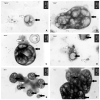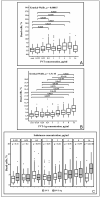NonToxic Silver/Poly-1-Vinyl-1,2,4-Triazole Nanocomposite Materials with Antibacterial Activity
- PMID: 32731519
- PMCID: PMC7466392
- DOI: 10.3390/nano10081477
NonToxic Silver/Poly-1-Vinyl-1,2,4-Triazole Nanocomposite Materials with Antibacterial Activity
Abstract
Novel silver/poly-1-vinyl-1,2,4-triazole nanocomposite materials-possessing antimicrobial activity against Gram-positive and Gram-negative bacteria-have been synthesized and characterized in the solid state and aqueous solution by complex of modern physical-chemical and biologic methods. TEM-monitoring has revealed the main stages of microbial cell (E. coli) destruction by novel nanocomposite. The concept of direct polarized destruction of microbes by nanosilver proposed by the authors allows the relationship between physicochemical and antimicrobial properties of novel nanocomposites. At the same time, it was shown that the nanocomposite was nontoxic to the fibroblast cell culture. Thus, the synthesized nanocomposite combining antibacterial activity against Gram-positive and Gram-negative bacteria as well as the absence of toxic effects on mammalian cells is a promising material for the development of catheters, coatings for medical devices.
Keywords: antimicrobial activity; nontoxic nanocomposite; poly-1-vinyl-1,2,4-triazole; silver nanoparticles.
Conflict of interest statement
The authors declare no conflict of interest.
Figures









References
-
- Shurygina I.A., Fadeeva T.V., Umanets V.A., Shurygin M.G., Grigoriev E.G., Sukhov B.G., Ganenko T.V., Kostyro Y.A., Trofimov B.A. Bactericidal action of Ag(0)-antithrombotic sulfated arabinogalactan nanocomposite: Coevolution of initial nanocomposite and living microbial cell to a novel nonliving nanocomposite. Nanomedicine. 2011;7:827–833. doi: 10.1016/j.nano.2011.03.003. - DOI - PubMed
LinkOut - more resources
Full Text Sources
Molecular Biology Databases

